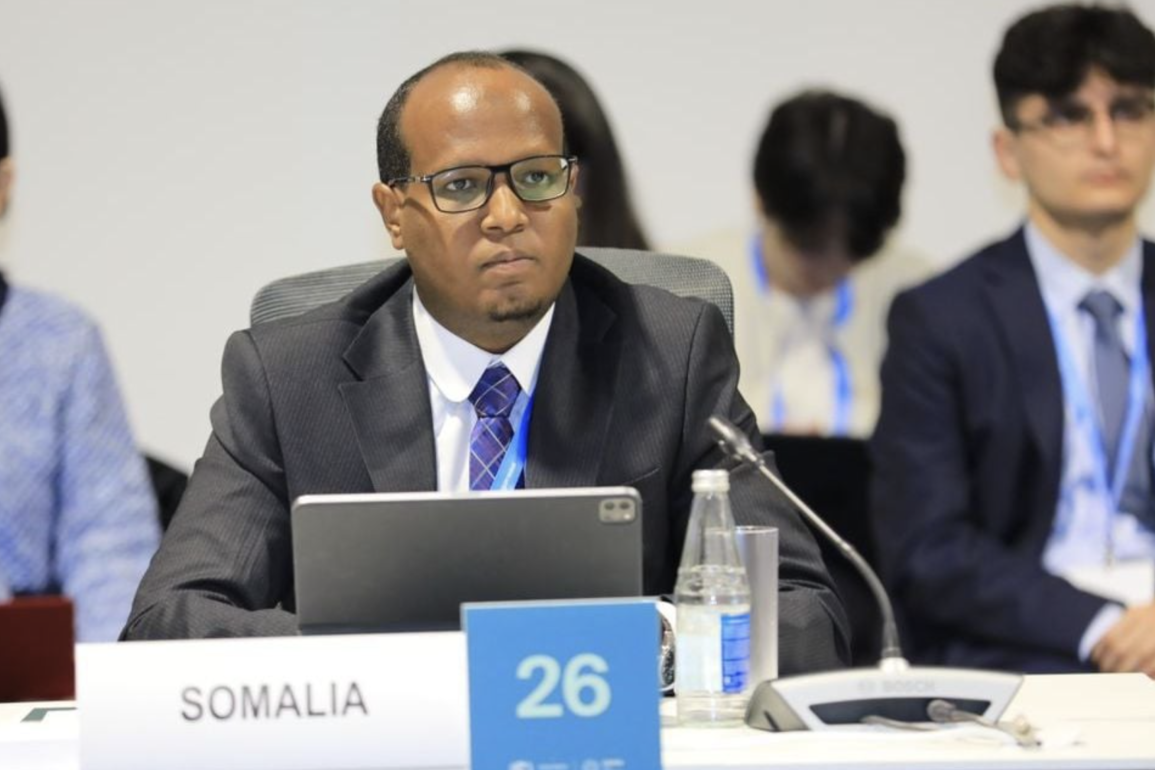At COP29 in Baku, Azerbaijan, Somalia’s voice resonated on the global stage with a clear message: technology is a vital tool in building climate resilience. Mr. Mustafa Yasin Sheik, Director General of the Somalia National Communications Authority (NCA), represented the country during the inaugural Digitalisation Day, underscoring Somalia’s commitment to using digital infrastructure to address the climate crisis.
Participating in a high-level roundtable on Green Digital Action, Sheik emphasized Somalia’s efforts in developing early warning systems, advancing climate data analysis, and improving resource management.
He also joined a distinguished panel discussion on AI for the UN’s Early Warnings for All (#EW4All) initiative, alongside experts from ITU, Google, McKinsey, and the Norwegian Meteorological Institute, to explore how AI can revolutionize global early warning systems and safeguard lives.
In an exclusive interview with Faustine Ngila, Sheik detailed Somalia’s technological strides and its vision for integrating innovation into climate resilience efforts. Below are excerpts from the interview, edited for clarity.
1. Somalia’s participation in Digitalisation Day at COP29 was a milestone. What key message did you aim to convey?
Somalia’s participation at COP29 was a statement of intent: we are committed to leveraging digital infrastructure to combat climate challenges. For a country facing prolonged droughts and extreme weather, tools like early warning systems and climate data analysis are not just beneficial—they are lifesaving. My message was that Somalia is not merely a victim of climate change but an active participant in seeking solutions.
2. Early warning systems were a focus of your discussions. How are they currently utilized in Somalia, and what role does the NCA play?
Early warning systems are central to minimizing the impact of climate-related disasters. The NCA collaborates with telecom operators and government agencies to disseminate alerts to vulnerable communities rapidly. We’re also integrating satellite data and mobile technologies to provide localized warnings, especially in rural areas, ensuring faster response times and greater community preparedness.
3. At the AI panel for the #EW4All initiative, you shared Somalia’s experiences. How is AI shaping your early warning mechanisms?
AI has transformative potential for early warning systems in Somalia. By analyzing vast datasets from meteorological stations, satellites, and local reports, AI enhances the accuracy of extreme weather predictions. Additionally, we are exploring AI-driven tools to map gaps in telecommunication coverage, ensuring that alerts reach even the most remote communities. Collaborations with organizations like ITU will further bolster these capabilities.
4. Somalia has made significant advancements in telecommunications. How do these developments align with your climate resilience agenda?
A robust telecommunications network is the backbone of our climate resilience strategy. The expansion of 4G and 5G services, coupled with the introduction of fiber optics, has improved connectivity nationwide. This infrastructure enables the efficient dissemination of early warnings, real-time data collection, and coordinated disaster responses. Moreover, mobile platforms now provide rural farmers and pastoralists with vital climate-related advisories.
5. What challenges does Somalia face in building digital infrastructure?
Our main challenges include limited resources, security concerns, and a need for capacity building. While Somalia is undergoing a digital transformation, scaling these efforts requires significant investment. Additionally, training our youth to sustain these advancements is crucial. Despite these hurdles, we are committed to overcoming them to ensure that no Somali is left behind.
6. Partnerships with global organizations like ITU seem pivotal. How do these collaborations support Somalia’s goals?
Global partnerships are indispensable. ITU, for instance, has played a key role in capacity building and establishing regulatory frameworks. Such collaborations provide the expertise, technology, and funding we need to accelerate our progress. They amplify Somalia’s efforts and position us as a leader in digital innovation on the global stage.
7. Beyond climate resilience, how is the NCA fostering innovation in Somalia’s telecom sector?
We are creating an enabling environment for innovation by encouraging competition and fair regulation. Recent initiatives include licensing new operators and supporting the rollout of mobile money platforms, making telecom services more accessible and affordable. Additionally, we’re fostering local startups to develop apps tailored to Somalia’s needs, focusing on sectors like agriculture, health, and education.
8. What lessons can other African nations draw from Somalia’s integration of technology and climate action?
One key lesson is aligning digital investments with societal priorities. For Somalia, climate resilience is a pressing challenge, so we’ve tailored our digital efforts accordingly. Other nations can adopt similar approaches by identifying their unique challenges and leveraging technology to address them. Collaboration and community involvement are also vital to ensure sustainable solutions.
9. Looking ahead, what are the NCA’s priorities for the next five years?
Our priorities include expanding digital infrastructure to underserved regions, enhancing early warning systems, and fostering local talent in technology. We also aim to achieve universal access to reliable, affordable telecommunications services. Strengthening international partnerships remains a cornerstone of our strategy, as we continue to seek innovative solutions for Somalia.
10. What inspires you to push for transformative changes in Somalia?
The resilience of the Somali people is my greatest inspiration. Despite decades of challenges, they remain hopeful and eager for a brighter future. Technology offers a path forward, whether it’s saving lives through early warnings or creating economic opportunities. Knowing that my work contributes to these efforts keeps me motivated every day.




